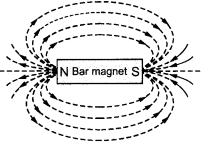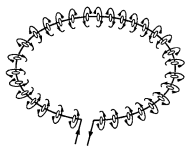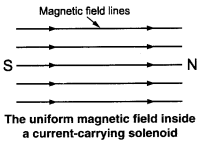Magnetic Effects of Electric Current
Solutions For All Chapters Science 10 CBSE
NCERT TEXTBOOK Solutions for Class 10 Science
Question 1
Which of the following correctly describes the magnetic field near a long straight wire ?
(a) the field consists of straight lines perpendicular to the wire
(b) the field consists of straight lines parallel to the wire
(c) the field consists of radial lines originating from the wire
(d) the field consists of concentric circles centred on the wire
Answer: (d) The field consists of concentric circles centred on the wire
Question 2
At the time of short circuit, the current in the circuit
(a) reduces substantially
(b) does not change
(c) increases heavily
(d) vary continuously
Answer: (c) Increases heavily.
Question 3.
State whether the following statements are True or False.
(a) The field at the centre a long circular coil carrying current will be parallel straight lines.
(b) A wire with a green insulation is usually the live wire of an electric supply.
Answer:
(a) True
(b) False.
Question 4. List two methods of producing magnetic fields.
Answer: – Two methods of producing magnetic fields are:
(i)By using a current-carrying straight conductor.
(ii)By using a solenoid.
Question 5.
When is the force experienced by a current-carrying conductor placed in a magnetic field largest ?
Answer:
When the conductor carries current in a direction perpendicular to the direction of the magnetic field, the force experienced by the conductor is largest.
Question 6.
Imagine that you are sitting in a chamber with your back to one wall. An electron beam, moving horizontally from back wall towards the front wall, is deflected by a strong magnetic field to your right side. What is the direction of magnetic field ?
Answer:
Here the electron beam is moving from our back wall to the front wall, so the direction of current will be in the opposite direction, from front wall towards back wall or towards us. The direction of deflection (or force) is towards our right side.
We now know two things :
1. direction of current is from front towards us, and
2. direction of force is towards our right side.
Let us now hold the forefinger, middle finger and thumb of our left hand at right angles to one another. We now adjust the hand in such a way that our centre finger points towards us (in the direction of current) and thumb points towards right side (in the direction of force). Now, if we look at our forefinger, it will be pointing vertically downwards. Since the direction of forefinger gives the direction of magnetic field, therefore, the magnetic field is in the vertically downward direction.
Question 7.
State the rule to determine the direction of a (i) magnetic field produced around a straight conductor-carrying current (ii) force experienced by a current-carrying straight conductor placed in a magnetic field which is perpendicular to it, and (iii) current induced in a coil due to its rotation in a magnetic field.
Answer:
(i) Right hand thumb rule : If the current carrying conductor is held in the right hand such that the thumb points in the direction of the current, then the direction of the curl of the fingers will give the direction of the magnetic field.
(ii) Fleming’s left hand rule : Magnetic Effects of Electric Current Stretch the forefinger, the central finger and the thumb of the left hand mutually perpendicular to each other. If the forefinger points in the direction of the magnetic field, the middle finger in the direction of current, then the thumb points in the direction of force in the conductor.
(iii) Fleming’s right hand rule : Stretch the thumb, forefinger and the central finger of the right hand mutually perpendicular to each other. If the forefinger points in the direction of magnetic field, thumb in the direction of motion of the conductor, then the middle finger points in the direction of current induced in the conductor.
Question 8.
When does an electric short circuit occur ?
Answer:
In a domestic circuit, short-circuit occurs when live and neutral wire come in direct contact with each other without any resistance. The resistance of the circuit becomes zero and excessive current starts to flow through it.
Question 9.
What is the function of an earth wire ? Why is it necessary to earth metallic appliances ?
Answer:
Earth wire is a safety measure that provides a low resistance conducting path to the current. Sometimes due to excess heat or wear and tear, the live wire comes in direct contact with the metallic cover of the appliances, which can give an electric shock on touching them. To prevent from the shock the metallic part is connected to the earth through a three-pin plug due to which the current flows to the earth at the instant there is a short circuit.
It is necessary to earth metallic appliances because it ensures that if there is any current leakage in the metallic cover, the potential of the appliance becomes equal to that of the earth. The potential of the earth is zero. As a result, the person handling the appliance will not get an electric shock.
NCERT Intext Questions for Class 10 Science Page Number: 196
Question 1
Why does a compass needle get deflected when brought near a bar magnet ?
Answer:
The magnetic field of the magnet exerts force on both the poles of the compass needle. The forces experienced by the two poles are equal and opposite. These two forces form a couple which deflects the compass needle.
NCERT Intext Questions for Class 10 Science Page Number: 200
Question 1
Draw magnetic field lines around a bar magnet.
Answer:
Question 2
List the properties of magnetic field lines.
Answer:
Properties of magnetic lines of force :
1. The magnetic field lines originate from the north pole of a magnet and end at its south pole.
2. The magnetic field lines become closer to each other near the poles of a magnet but they are widely separated at other places.
3. Two magnetic field lines do not intersect one another.
Q3. Why don’t two magnetic field lines intersect each other?
Answer:- If two magnetic field lines of force intersect each other then at the point of intersection, the compass needle would show two different directions which is not possible.
NCERT Intext Questions for Class 10 Science Page Number: 201- 202
Question 1
Consider a circular loop of wire lying on the plane of the table. Let the current pass through the loop clockwise. Apply the right hand rule to find out the direction of the magnetic field inside and outside the loop.
Answer:
As shown in figure alongside, each section of wire produces its concentric set of lines of force. By applying right hand thumb rule, we find that all the sections produce magnetic field downwards at all points inside the loop while at the outside points, the field is directed upwards. Therefore, the magnetic field acts normally into the plane of the paper at the points inside the loop and normally out of the plane of paper at points outside the loop.
Question 2
The magnetic field in a given region is uniform. Draw a diagram to represent it.
Answer:
A uniform magnetic field in a region is represented by drawing parallel straight lines, ail pointing in the same direction.
For example, the uniform magnetic field which exists inside a current-carrying solenoid can be represented by parallel straight lines pointing from its S-pole to N-pole (as shown in figure).
Question 3
Choose the correct option.
The magnetic field inside a long straight solenoid-carrying current
(a) is zero
(b) decreases as we move towards its end
(c) increases as we move towards its end
(d) is the same at all points
Answer:
(iv) Is the same at all points.
NCERT Intext Questions for Class 10 Science Page Number: 203 – 204
Question 1
Which of the following property of a proton can change while it moves freely in a magnetic field. (There may be more than one correct answer.)
(i) Mass
(ii) Speed
(iii) Velocity
(iv) Momentum
Answer:
The correct options are (iii) velocity, (iv) momentum.
Question 2
In Activity 12.7 how do we think the displacement of rod AB will be affected if (i) current in rod AB is increased (ii) a stronger horse-shoe magnet is used; and (iii) length of the rod AB is increased ?
Answer:
(i) When the current in the rod AB is increased, force exerted on the conductor increases, so the displacement of the rod increases.
(ii) When a stronger horse-shoe magnet is used, the magnitude of the magnetic field increases. This increases the force exerted on the rod and the displacement of the rod.
(iii) When the length of the rod AB is increased, force exerted on the conductor increases, so the displacement of the rod increases.
Question 3
A positively-charged particle (alpha particle) projected towards west is deflected towards north by a magnetic field.
The direction of magnetic field is :
(i) towards south
(ii) towards east
(iii) downward
(iv) upward
Answer:
(iv) Upward.
Here, the positively charged alpha particles are moving towards west, so the direction of current is towards east. The deflection is towards north, so the force is towards north, so, we are given that
(i) direction of current is towards west
(ii) direction of force is towards north.
Let us now hold the forefinger, middle finger and thumb of our left-hand at right angles to one another. Adjust the hand in such a way that our mid finger points towards west (in the direction of current) and thumb points towards north (in the direction of force). Now, if we look at our forefinger, it will be pointing upward. Because the direction of forefinger gives the direction of magnetic field, therefore, the magnetic field is in the upward direction.
NCERT Intext Questions for Class 10 Science Page Number: 205
Question 1
Name two safety measures commonly used in electric circuits and appliances.
Answer:
(i) Earthing and
(ii) Electric fuse.
Question 2
An electric oven of 2 kW power rating is operated in a domestic electric circuit (220 V) that has a current rating of 5 A. What result do you expect ? Explain.
Answer:
The electric oven draws a current given by
Thus the electric oven draws current much more than the current rating 5 A. That is the circuit is overloaded. Due to excessive current, the fuse wire will blow and the circuit will break.
What precautions should be taken to avoid the overloading of domestic electric circuits ?
To avoid the overloading of domestic electric circuits, the following precautions should be taken :
(i) The wires used in the circuit must be coated with good insulating materials like PVC, etc.
(ii) The circuit must be divided into different sections and a safety fuse must be used in each section.
(iii) High power appliances like air-conditioner, refrigerator, a water heater, etc. should not be used simultaneously.
Q3. What precaution should be taken to avoid the overloading of domestic electric circuits?
Answer : The precautions that should be taken to avoid the overloading of domestic circuits are as follows: Too many appliances should not be connected to a single socket. Too many appliances should not be used at the same time. Faulty appliances should not be connected in the circuit. Fuse should be connected in the circuit.




Leave a Reply